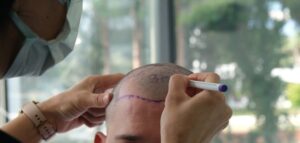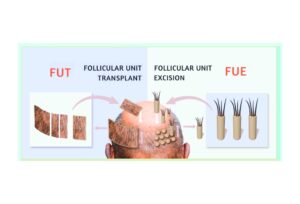If hair loss is affecting your self-esteem, you’re undoubtedly familiar with the many options for trying to cover it up. Your closet is probably full of hats, wigs or scarves, and you might even deliberately avoid social situations that would force you to reveal the full extent of your hair loss to your friends or family.
You may be interested in hair transplant surgery to restore lost locks, but don’t know enough about it to feel comfortable committing to it. Despite the popularity of hair transplants – and rapid advancements in surgical techniques – there are still many persistent rumours that have made some people avoid getting this life-changing procedure. This post is going to debunk some of the most common misconceptions about hair loss surgery.
Myth 1: Hair transplants only work for younger patients.
You may have heard it’s better to get a hair transplant when you’re relatively young and your hair has just begun to thin and recede. However, for most hair transplantation surgeries, there is a better chance of a successful outcome for slightly older patients. That’s because it can be difficult to predict the future hair loss pattern of younger patients, even for an expert.
Your hair loss can advance as you get older, negating the results of the original surgery. If you receive a hair transplant to fill in a thinning crown in your early 20s, by the time you reach your 40s, you could end up with an island of strong transplanted hair in the middle, while patches continue to fall out around it.
Myth 2: You’ll wake up the next day with a full head of hair.
Just like your normal hair, hair transplants take time to grow. The transplanted hair will grow gradually and can take up to a full year before you see your final results. Though you won’t be able to enjoy a full head of hair immediately after the surgery, you will be able to see the shape of your new hairline. Over the course of the next several months, your new hair will continue to grow and blend in perfectly.
Myth 3: Your hair transplant will look too obvious.
Follicular unit excision (FUE) is an innovative technique for hair restoration surgery that allows a skilled surgeon to place each individual hair graft precisely into place. Because this method gives surgeons such a high degree of control over the placement and direction of the hair, it creates totally natural-looking results. Also, unlike older hair transplantation surgeries, FUE does not leave patients with a linear scar. Even if you choose to cut your hair short, the evidence of FUE surgery will be virtually undetectable.
Myth 4: Only men can get hair transplants.
While male pattern baldness and female pattern baldness are biologically different, both men and women suffer from hair loss. Hair transplants are more common for male patients, but there’s no reason women with thinning hair can’t benefit from the surgery, too.
Myth 5: You can use someone else’s hair for your transplant.
The quality of your donor hair is the best criterion to help a hair surgeon determine whether you are a good candidate for this procedure. Doctors use the Norwood scale to classify male hair loss, for example. On this scale, class 1 represents no visible hair loss, while class 7 is advanced baldness across the entire scalp. If you fall within class 7, a hair transplant won’t be successful for you because you lack enough donor hair. You may have heard you can use donor hair follicles from a different person, but the truth is that your body would reject them as foreign.
Myth 6: Hair transplant surgery is painful.
The procedure itself is not painful, since the scalp is anaesthetized beforehand. The only part of the procedure that could cause some discomfort is the administering of the anaesthetic itself, although most patients don’t report any problems tolerating this. During your treatment, you can sit and read a book or catch up on your favourite TV series. After the surgery, most patients find that they do not need any medication to control the pain.
Myth 7: It is risky to get hair loss surgery.
If you choose to get FUE, the risks and recovery time are very minimal, and you will not have any stitches, sutures or bandages. You can return immediately to work and other normal daily activities. The most common side effects are minor redness and swelling, which will diminish over the first few days.
Myth 8: Washing my hair will make it stop growing.
After the first week to 10 days, the hair follicles will be well-established in their new location, and you will be allowed to wash, comb and cut your hair as usual. In fact, shampooing the area keeps it clean, which helps minimize the risk of infection.
Myth 9: The more grafts you get, the better your results will be.
The number of hair grafts it will take to restore your hair is based on how far your baldness has advanced. While it will take more hair grafts to cover widespread baldness, the quantity of the grafts doesn’t necessarily indicate the quality of the results. A skilled hair transplant surgeon will be able to tell you how many grafts you will need for your degree of hair loss.
Myth 10: Hair transplants are not permanent.
The hair that grows on the back and sides of your head is genetically programmed to be permanent. The hair retains this quality even after getting transplanted to the top of the head. However, a hair transplant surgery will not keep you from experiencing hair loss that would have occurred regardless of whether you had the procedure. You can use treatments such as ketoconazole, finasteride (brand name Propecia) or minoxidil (brand name Rogaine) to prevent additional hair loss.
Myth 11: Hair transplant surgery is overly expensive.
The top factor influencing the cost of your hair loss surgery is how many grafts you will need. If you’ve been shopping around for hair transplant surgeons, you may see widely ranging costs per graft. Don’t just automatically choose the surgeon offering the lowest rate. You’ll need to consider other factors as well, such as the quality of their work, their level of experience and the results they have given other patients. Many hair restoration doctors also offer financing to put the investment within reach for more people.
Myth 12: It doesn’t matter who performs your hair restoration surgery.
The popularity of hair restoration has led some doctors whose background is in a different branch of medicine to begin offering hair restoration surgery. That’s why it’s important to research several different doctors and clinics to ensure you are choosing an experienced, qualified surgeon who has dedicated their practice to the art and science of hair transplantation.
As home to one of the world’s most renowned experts in FUE, Toronto-area based the Toronto Hair Transplant Surgeons, is a specialist centre focused solely on hair restoration and surgery. Contact the Toronto Hair Transplant Surgeons today and book a personal consultation with one of our highly renowned doctors.

















